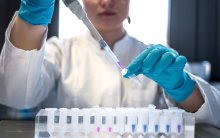Tiziana Alberio, Mauro Fasano, Marta Lualdi
The Biochemistry and Functional Proteomics lab research is mainly focused on protein biochemistry. Our projects focus on Parkinson's Disease with two main goals: the elucidation of pathogenetic mechanisms and the discovery of peripheral biomarkers. We both use standard biochemistry methods and proteomics to find proteins and pathways involved in neurodegenerative processes. We employ in-house routines to statistically analyze omics data and the systems biology approach to interpret complex results. We have established several collaborations to describe Parkinson's Disease specific mechanisms from general pathways of neurodegeneration and we are often involved in other neuroscience projects in order to analyze and interpret complex data.
Our research topics are focused on the structure, function and regulation of ion channels and membrane transporters involved in numerous diseases, such as Parkinson and chronic pain. By using electrophysiological techniques, molecular biology, immunochemical, biochemical and fluorimetric techniques, several proteins involved in the membrane translocation of ions and solutes have been studied and characterized by the laboratory of cellular and molecular physiology. Electrogenic membrane transporters are the main subject of research: the protein belonging to neurotransmitter sodium symporter or SLC6 family, like GAT1, GlyT1, DAT and B0AT1 are studied. Moreover, other transporters involved in neurotransmission are also investigated, like SLC1 glutamate transporters and in gut-brain relationships also SLC15a family (PEPT1 oligo-peptides transporters) is also deeply studied. Recently we have also investigated some TRP channels and their role in chronic pain onset and persistence. The proteins are studied in heterologous systems: Xenopus oocytes or cell lines. In these cells cDNAs coding for wild type or recombinant proteins are transfected or membrane collected from healthy or pathological human tissue transplanted. The functional and/or pharmacological characterization is usually conducted by two-electrode voltage clamp, but also by uptake using fluorescent probes and HPLC methods. Quantification or alteration in protein expression is studied by immunochemistry or qPCR approaches
Our main research topics are centered on the cellular and molecular mechanisms involved in the adaptive changes occurring in the enteric nervous system which underlay the pathophysiology of main gut diseases, such as intestinal ischemia/reperfusion injury, intestinal inflammation and irritable bowel syndrome. In this regard, we are currently focusing our research on the relevance of the enteric microenvironment and the microbiota in the development of enteric neuropathies underlying intestinal ischemia and inflammation
Callegari Camilla, Marta Ielmini (PhD), Ivano Caselli (PhD)
The research activity of the Psychiatry group deals with the following areas:
Resilience.
Pharmacogenetic applications in the treatment of Bipolar Disorder.
Fictitious disorders, dissociative disorders of consciousness.
Major Depressive Disorder, in particular age groups; pathophysiological relationships between genetic biomarkers and immune system.
Ethnopsychiatry and cultural psychiatry. Psychopathology of migratory trauma and psychiatric disorders in the migrant population.
Post traumatic disorders related to somatic disease.
Marco Cosentino, Franca Marino
Our main research interests concern neuro- and immunopharmacology with particular regard to the neuroendocrine modulation of immune response. Recent research: pharmacological modulation of endogenous catecholamines in human lymphocytes and its functional relevance in health and disease such as multiple sclerosis and Parkinson's disease. Other interests: clinical pharmacology and pharmacogenetics, pharmacoepidemiology and pharmacovigilance, pharmacology of herbal medicines.
The recent research topic in the lab is the study of functional effects of acute stress (AS) on synaptic transmission and membrane excitability of neurons in the rodent prefrontal cortex (PFC). We are exploring AS effects on miniature and spontaneous synaptic currents, on synaptic plasticity (LTP, LTD) and membrane firing regulation in various regions and layers of the PFC. Our expertise includes electrophysiological patch-clamp recordings, field potential recordings, planar multielectrode arrays recordings and Ca2+ imaging, in brain slices and cultured cells. My past interests were focused mainly on cerebellar physiology, including patch-clamp and Ca2+ imaging studies of synaptic inputs to cerebellar granular layer interneurons, regulation of their pacemaker firing, and axonal action potential propagation in molecular layer interneurons.
Collaborations:
Charlotte Kilstrup-Nielsen - DBSV, Univ. dell’Insubria
Maurizio Popoli - Università di Milano
Laura Musazzi - Università di Milano-Bicocca
Charlotte Kilstrup-Nielsen, Isabella Barbiero
The research focus of the laboratory of Molecular Neurobiology is to characterize the functions of X-linked kinase CDKL5 in the nervous system and the consequences of its deficiency, leading in humans to a severe neurologic disorder. The goal of our studies is to provide data that can pave the way for therapeutic approaches. For these studies we make large use of Cdkl5-KO neurons and mice. We have through our studies contributed significantly to the current knowledge of CDKL5 functions and the consequences of some pathologic mutations. We also showed that in neurons, CDKL5 levels are tightly controlled by phosphorylation-dependent degradation. Our present focus is to characterize synaptic defects in CDKL5 deficient neurons and the role of CDKL5 in regulating microtubule dynamics. We have demonstrated that surface expression of the AMPA-receptor subunit GluA2 is reduced in Cdkl5-KO neurons but can be restored upon treatment with the antidepressant drug Tianeptine. Regarding microtubules, we have identified the +TIP CLIP170 as an import downstream effector of CDKL5 possibly representing a novel druggable target for CDKL5 deficiency disorder.
Collaborations:
Lia Forti - DBSV, Univ. dell’Insubria
Flavia Antonucci - Università di Milano
Maurizio Giustetto e Andrea Marcantoni - Università di Torino
Massimiliano Bianchi - Trinity College Dublin
Ongoing Research spans the fields of:
Neurodegenerative diseases (dementias, movement disorders, ALS): imaging biomarkers in mild cognitive impairment; role of neuroinflammation and peripheral immunity in Parkinson's and Alzheimer's Diseases (in collaboration with Prof. M.Cosentino); peripheral markers of neurodegeneration processes: d-serine (in collaboration with Prof. L.Pollegioni).
Encephalopathies secondary to infectious (SARS COV 2) and dysimmune diseases (rapidly progressive dementias in dysimmune encephalitis)
Collaborations:
Prof.L. Pollegioni - DBSV, Univ. dell’Insubria
Prof. M.Cosentino – DMC, Univ. dell’Insubria
Tiziana Rubino, Erica Zamberletti
Ongoing research lines in the lab are aimed at evaluating: 1) The therapeutic potential of some phytocannabinoids in models of autism; 2) The role of the endocannabinoid system in the pathogenesis of psychiatric disorders; 3) The ability of cannabidiol to modulate the long-term negative consequences of adolescent delta-9-tetrahydrocannabinol exposure on the brain; 4) the role of the endocannabinoid system in adolescent brain maturation/remodeling
We work in molecular mechanisms involved in the regulation of the catabolism of the atypical neuromodulators D-serine (D-Ser) and D-aspartate (D-Asp) in the brain. D-Ser is an essential activator of the NMDA receptors since it acts as the principal co-agonist, while D-Asp is an alternative agonist. Alterations in their metabolism have been shown to affect the receptor functionality, thus being implicated in several neurological disorders, among which schizophrenia, AD and ALS. In particular, we are interested in deciphering how the functional properties of the two human FAD-dependent flavooxidases responsible for the degradation of D-Ser and D-Asp - D-amino acid oxidase (hDAAO) and D-aspartate oxidase (hDDO), respectively - are modulated (cofactor/ligand binding, interaction with regulatory proteins, subcellular localization, degradation pathway). Indeed, despite their relevant physiological role, little is known about the processes entailed in establishing hDAAO and hDDO cellular levels and activity. Investigating them will provide crucial information concerning the regulation of D-Ser and D-Asp levels in the brain, with remarkable implications for the understanding of the modulation of NMDAR-mediated neurotransmission in physiological and pathological conditions. Furthermore, since the precursor L-Ser, synthesized via the so called “phosphorylated pathway”, is the key rate-limiting factor for maintaining steady-state levels of D-Ser in the adult brain (it is converted to the D-enantiomer by serine racemase), we recently started to study the enzymes catalyzing the different biosynthetc steps: phosphoglycerate dehydrogenase (PHGDH), phosphoserine aminotransferase (PSAT) and phosphoserine phosphatase (PSP). Again, the factors affecting the amount and the activity of these enzymes are still largely elusive. Thus we are investingating the L-Ser pathway using various biochemical approaches, cell model systems and brain samples, with the ambitious aim to identify potential molecular targets and propose alternative strategies to modulate D-Ser levels.
Browse the section
For information
Via Manara 7, 21052 Busto Arsizio (VA) – Italy
Tel. +39 0332 421392
e-mail: centro.neuroscienze@uninsubria.it
Administration
Adriana Jacona
Director
Lia Forti
The Center for Research in Neuroscience is a part of the Department of Biotechnology and Life Sciences (DBSV)





